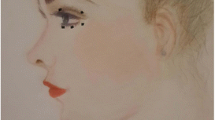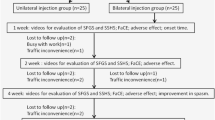Summary
Botulinum toxin (BTX) has become a safe and effective therapeutic tool in the treatment of a variety of neurological disorders, especially dystonias. One major disadvantage, however, is the high cost of a single injection of BTX. In this study of 835 patients, we calculated the cost of treatment with BTX serotype A (BTX-A) for different dystonias and hemifacial spasm.
The annual expenditure per patient for BTX-A injections in this cohort totalled (mean ± standard deviation) 1030 Deutschmarks (DM) 1996 values ±DM610 [$US570 ± $US340; 230 ± 130 pounds sterling (£)] for blepharospasm (n = 158), DM1450 ±DM1520 ($US800 ± $US830; £310 ±£280) for craniocervical dystonia (n = 148), and DM1480 ± DM780 ($US810 ± $US430; £330 ± £180) for oromandibular dystonia (n = 16), while the treatment of cervical dystonia consumed DM4590 ±DM2060 ($US2520 ± $US1130; £960 ± £420) [n = 362] per patient. In order to alleviate symptoms in patients with hemifacial spasm (n = 151), DM51 0 ± DM270 ($US280 ± $US150; £110 ± £60) had to be spent annually. The expenses for surgical therapy for cervical dystonia were DM10 120 ± DM1900 (n= 54). No major differences concerning expenditure could be found in this study between the 2 available preparations of BTX. However, there appeared to be a lower rate of adverse effects with the Botox® formulation, compared with the Dysport® formulation, of BTX- (this difference was statistically significant i.e. p<0.001)
Although the cost of an individual injection is high, other cost factors also substantially contribute to the societal costs of adult-onset dystonias. Some of these costs may be attenuated with the use of BTX. The subjective and objective relief of these socially devastating and sometimes painful conditions rewards the expenditure associated with the use of BTX-A
Similar content being viewed by others
References
Scott AB. Botulinumtoxin injection into extraocular muscles as alternative to strabismus surgery. J Pediatr Ophthalmol Strabismus 1980; 17: 21–5
Jankovic J, Hallett M. Therapy with botulinum toxin. New York: Martin Dekker, 1994
Blitzer A, Brin ME. Laryngeal dystonia: a series with botulinum toxin therapy. Ann Otol Rhinol Laryngol 1991; 100: 85–9
Csala B, Deuschl G. Craniocervical dystonias: descriptive category or nosological entity. Nervenarzt 1994; 65: 75–94
Laskavi R, Ellis M, Drobik C, et al. Botulinum toxin treatment in patients with hemifacial spasm. Eur Arch Otorhinolaryngol 1994; 251: 271–4
Grazko MA, Polo KB, Jabbari B. Botulinum-toxin A for spasticity, muscular spasms and rigidity. Neurology 1995; 45: 712–7
Davis D, Jabbari B. Significant improvement of stiff-person syndrome after paraspinal injection of botulinum toxin A. Mov Disord 1994; 8: 371–3
Jankovic J, Schwartz K. Botulinum toxin treatment of tremors. Neurology 1991; 41: 1185–8
Schneider P, Schmied M, Berger T, et al. Therapeutische Anwendung von Botulinum A Toxin in der Neurologie. WienKlin Wochenschr 1994; 106: 335–44
Albanese A, Bentivoglio AR, Cassetta E, et al. Review article: the use of botulinum toxin in the alimentary tract. AlimentPharmacol Ther 1995; 9: 599–604
Keen M, Blitzer A, Aviv J, et al. Botulinumtoxin A for hyperkinetic facial lines: results of a double-blind, placebocontrolledstudy. Plast Reconstr Surg 1994; 94: 94–9
Louis ED. Prevalence of focal dystonias in the western area of Tottori prefecture in Japan. Mov Disord 1996; 11: 342–3
Claypool DW, Duane DD, Ilstrup DM, et al. Epidemiology and outcome of cervical dystonia (spasmodic torticollis) in Rochester,Minnesota. Mov Disord 1995; 10: 608–14
Nutt G, Muenter MD, Aronson A, et al. Epidemiology of focal generalized dystonia in Rochester, Minnesota. Mov Disord 1988; 3: 188–94
Auger RG, Whisnant JP. Hemifacial spasm in Rochester and Olmsted country, Minnesota 1960-1984. Arch Neurol 1990; 47: 1233–4
Fahn S, Marsden CD, Calne DB. Classification and investigation of dystonia. In: Marsden CD, Fahn S, editors. Movementdisorders 2. London: Butterworth, 1987: 359–82
Thompson PD, Obeso JA, Delgado G, et al. Focal dystonia of the jaw and the differential diagnosis of unilateral jaw andmasticatory spasm. J Neurol Neurosurg Psychiatry 1986; 49:651-6
Marsden CD, Quinn NP. The dystonias. BMJ 1990; 300: 139–44
Jahanshahi M, Marion MH, Marsden CD. Natural history of adult-onset idiopathic torticollis. Arch Neurol 1990; 47: 548–52
Friedman A, Fahn S. Spontaneous remissions in spasmodic torticollis. Neurology 1986; 36: 398–400
Duchen LW. An electron microscopic study of the changes induced by botulinum toxin in the motor end-plates of slow andfast skeletal muscle fibers of the mouse. J Neurol Sci S971; 14: 47–60
Dasgupta BR. Structure of botulinum neurotoxin, its functional domains, and perspectives on the crystalline type A toxin. In: Jankovic J, Hallett M, editors. Therapy with botulinum toxin. New York: Marcel Dekker, 1994: 15–39
Montecucco C, Schiavo G. Mechanism of action of tetanus and botulinum neurotoxins. Mol Microbiol 1994; 13: 1–8
Hanig JP, Lamanna C. Toxicity of botulinum toxin: a stochiometric model for the locus of its extraordinary potencyand persistence at the neuromuscular junction. J Theor Biol 1979; 77: 103–9
Mezaki T, Kaji R, Kohara N, et al. Comparison of therapeutic efficacies of type Aand F botulinum toxin for blepharospasm:a double-blind controlled study. Neurology 1995; 45: 506–8
Tsui JKC, Hayward M, Mak EKM, et al. Botulinum toxin type B in the treatment of cervical dystonia: a pilot study. Neurology 1995; 45: 2108–11
Ludlow CL, Hallett M, Rhew K, et al. Therapeutic use of type F botulinum toxin [letter]. N Engl J Med 1992; 326: 349–50
Therapeutics and technology assessment subcommittee of the American Academy of Neurology. Training guidelines for theuse of botulinum toxin for the treatment of neurologic disorders. Neurology 1994; 44: 2401–3
Greene P, Fahn S, Brin MF, et al. Botulinum toxin therapy. In: Marsden CD, Fahn S, editors. Movement disorders 3. London: Butterworth, 1995: 477–502
Brin MF, Fahn S, Moskowitz C, et al. Localized injections of botulinum toxin for the treatment of focal dystonia and hemifacialspasm. Mov Disord 1987; 2: 237–54
Jankovic J. Botulinum toxin in movement disorders. Curr Opin Neurol 1994; 7: 358–66
Gudex CM, Hawthorne MR, Butler AG, et al. Cost utility analysis of botulinum toxin therapy in the treatment of dystonia [abstract]. Mov Disord 1994; 10: 373
Bochner F, Martin ED, Burgess NG, et al. How can hospitals ration drugs? BMJ 1994; 308: 901–5
IMS World Publications Ltd. Drug launches. Philadelphia: IMS, 1996
Weiner WJ, Lang AE. Drug-induced movement disorders. In: Weiner WJ, Lang AE, editors. Movement disorders: a comprehensivesurvey. Mount Kisco: Futura, 1989: 599–644
Lepore FE, Duvoisin RC. ‘Apraxia’ of eyelid opening: an involuntary levator inhibition. Neurology 1985; 35: 423–7
Blackie JD, Lees AJ. Botulinum toxin treatment in spasmodic torticollis. J Neurol Neurosurg Psychiatry 1990; 53: 640–3
Comella CL, Buchman AS, Tanner CM, et al. Botulinum toxin injections for spasmodic torticollis: increased magnitude ofbenefit with electromyographic assistance. Neurology 1992; 42: 878–82
Speelman JD, Brans JW. Cervical dystonia and botulinum treatment: is electromyographic guidance necessary? Mov Disord 1995; 10: 802
Ceballos-Baumann AO, Gasser T, Dengler R, et al. Lokale injektionsbehandlung mit Botulinumtoxin A bei Blepharospasmus,Meige-syndrom und Spasmus hemifacialis. Nervenarzt 1990; 60: 604–10
Biglan AW, May M, Bowers RA. Management of facial spasm with C. botulinum toxin type A. Arch Otolaryngol Head NeckSurg 1988; 114: 1407–12
Fahn S, Greene P. Hemifacial spasm. In: Johnson RT, editor. Therapy in neurologic diseases. Philadelphia: BC Decker,1990: 108–42
Burke RE, Fahn S, Marsden CD, et al. Validity and reliability of a rating scale for the primary dystonias. Neurology 1985; 35: 73–7
Marsden CD, Schachter M. Assessment of extrapyramidal disorders. Br J Pharmacol 1981; 11: 129–51
Jankovic J, Schwartz KS. Clinical correlates of response to botulinum toxin injections. Arch Neuro1 1991; 48: 1253–6
Jankovic J, Schwartz KS. Longitudinal experience with botulinum toxin injections for treatment of blepharospasm and cervicaldystonia. Neurology 1993; 43: 834–6
Erbguth F, Kilian K-D, Claus D, et al. Behandlung des Torticollis spasmodicus mit lokalen Injektionen von Botulinustoxin A. Deutsch Med Wochen 1991; 116: 567–72
Gelb DJ, Lowenstein DH, Aminoff MJ. Controlled trial of botulinumtoxin injections in the treatment of spasmodic torticollis. Neurology 1989; 39: 80–6
Mundenbruch R. Gebuhrenordnung fur Arzte, GOA, BGGOA. Dachau: Zauner Druck und Verlags GmbH, 1994
Mundenbruch R. BMA, E-GO, EBM. Dachau: Zauner Druck und Verlags GmbH, 1995
Braun V, Richter HP. Selective peripheral denervation for the treatment of spasmodic torticollis. Neurosurgery 1994; 35: 58–62
Braun V, Richter HP, Schroder JM. Selective peripheral denervation for spasmodic torticollis: is the outcome predictable? J Neurol 1995; 242: 504–7
Bertrand C, Molina-Negro P, Bouvier G, et al. Observations and analysis of results in 131 cases of spasmodic torticollis afterselective denervation. Appl Neurophysiol 1987; 50: 319–23
Hartunian NS, Smart CN, Thompson MS. The incidence and economic costs of cancer, motor vehicle injuries, coronaryheart disease and stroke: a comparative analysis. Am J Public Health 1994; 70: 1249–60
Statistisches Bundesamt. Statistisches lahrbuch. Wiesbaden: Metzler-Poeschel-Verlag, 1995
Bundesverband der pharmazeutischen Industrie. Rote Liste 1996. Frankfurt: Cantor- Verlag, 1996
British Medical Association, Royal Pharmaceutical Society of Great Britain. British National Formulary. Wallingford: ThePharmaceutical Press, 1996
Medical Economics Company. Drug Topics Red Book. Montvale: Medical Economics Company, 1996
Soland VL, Bhatia KP, Marsden CD. Sex prevalence of focal dystonias. J Neurol Neurosurg Psychiatry 1996; 60: 204–5
Sloop RR, Cole BA, Escutin RO. Reconstituted botulinum toxin type Adoes not lose potency in humans if it is refrozenor refrigerated for 2 weeks before use. Neurology 1997; 48: 249–53
Impulse Research Corporation. Dystonia information needs survey. Los Angeles: Dystonia Medical Research Foundation, 1997
Jankovic J, Leder S, Warner 0, et al. Cervical dystonia: clinical findings and associated movement disorders. Neurology 1991; 41: 1088–91
Lang AE, Sheeky MP, Marsden CD. Acute anticholinergic action in focal dystonia. Adv Neurol 1983; 37: 193–200
Lal S. Pathophysiology and pharmacotherapy of spasmodic torticollis: a review. Can J Neurol Sci 1979; 6: 427–35
Schantz EJ, J0hnson EA. Properties and use of botulinum toxin and other microbial neurotoxins in medicine. Microbiol Rev 1992; 56: 80–99
Van den Bergh P, Francart J, Mourin S, et al. Five–year experience in the treatment of focal movement disorders with lowdoseDysport® botulinum toxin. Muscle Nerve 1995; 18: 720–9
Brin MF, Blitzer A. Botulinum toxin: dangerous terminology errors. J R Soc Med 1993; 86: 493–4
Odergreen T, Tollback A, Borg J. Efficacy of botulinum toxin for cervical dystonia: a comparison of methods for evaluation. Scand J Rehabil Med 1995; 26: 191–5
Jahanshahi M, Marsden CD. Psychological fuctioning before and after treatment of torticollis with botulinum toxin. J Neurol Neurosurg Psychiatry 1992; 55: 229–31
Author information
Authors and Affiliations
Rights and permissions
About this article
Cite this article
Dodel, R.C., Kirchner, A., Koehne-Volland, R. et al. Costs of Treating Dystonias and Hemifacial Spasm with Botulinum Toxin A. Pharmacoeconomics 12, 695–706 (1997). https://doi.org/10.2165/00019053-199712060-00009
Published:
Issue Date:
DOI: https://doi.org/10.2165/00019053-199712060-00009




